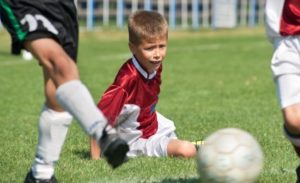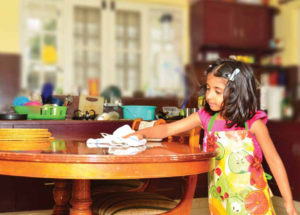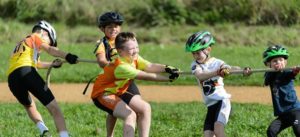Athletes are known for their emotional strength. Competing at a high level in any sport can be an emotional turmoil filled with highs and lows. Right from a young age, some athletes are battling their opponents alone in that huge ring or a large tennis court. Who teaches them emotional control or right mind frame? Emotional control on the field or in  the ring comes with practice. However, not all athletes are comfortable with the idea of competing without having some form of emotional support outside the court, field or ring. Someone you trust, someone who comforts you- It could be a parent, coach or a friend. Similarly, some people like to have partners to go to the gym or someone they could exercise with. Some exercisers may also depend on their instructor for emotional and mental support.
the ring comes with practice. However, not all athletes are comfortable with the idea of competing without having some form of emotional support outside the court, field or ring. Someone you trust, someone who comforts you- It could be a parent, coach or a friend. Similarly, some people like to have partners to go to the gym or someone they could exercise with. Some exercisers may also depend on their instructor for emotional and mental support.
Why is emotional independence so important in competitive sport?
In the experimental conditions, 20 competitive cyclists watched an upsetting video before performing a 10 km cycle task. When participants suppressed their emotional reactions to the video (suppression condition) they completed the cycling task slower, generated lower mean power outputs, and reached a lower maximum heart rate and perceived greater physical exertion than when they were given no self-regulation instructions during the video (non-suppression condition) and received no video treatment (control condition)(Wagstaff, 2014). Negative emotions can have a great impact on performance and practice.
Generally, as human beings, we turn to our parents, friends or family members for emotional support. Everyday practice sessions for an athlete may have ups and downs; however, after gathering emotional support from a loved  one, the athlete’s practice session might’ve been better than expected. This situation might have the possibility of conditioning the athlete’s mind to gain emotional support from that person and cause emotional dependence. The problem occurs if the athlete is in a competition and needs emotional support in absence of their emotional buffer.
one, the athlete’s practice session might’ve been better than expected. This situation might have the possibility of conditioning the athlete’s mind to gain emotional support from that person and cause emotional dependence. The problem occurs if the athlete is in a competition and needs emotional support in absence of their emotional buffer.
Lazarus (2000) suggested that focus on process needs to be emphasized rather than structure in stressful conditions. When an athlete is losing a match, it is important to drive their focus on the process rather than thinking ‘Oh, I am going to lose’. Athletes who can compartmentalize their emotions and focus on the process tend to be more successful in competitions.
Practice conditions
Coaches often design training sessions in line with competition conditions of pressure. Athletes who train in pressure situations are able to develop necessary skills and transfer those skills in competitive situations. There are two strategies for dealing with emotions (Wagstaff et al, 2013). One is adapting your thought pattern to adapt to the situation while the other is about suppressing the emotion. The former strategy is a better coping mechanism in stressful situations.
How to promote emotional independence in young athletes?
- Change of environment
In an athlete’s situation, a different practice camp which is away from their parents, friends, familiar athletes and family might be a good idea for a few months. This will give the athlete an opportunity to become emotionally independent without an emotional buffer during practice sessions which will break the mental conditioning process of being emotionally comforted and help facilitate the logical over emotional behavior during a performance.
- Conscious effort
 Consciously trying to become emotionally independent off the field will help in becoming emotionally independent on the field. Parents can give their children everyday tasks like helping in the kitchen or tidying one shared corner of the house for them to become independent and feel responsible for their actions. Offering support at the beginning can be useful but reduce the amount of support eventually and let your child take full responsibility for the task. When they feel responsible in everyday life, they will feel responsible on the field/court.
Consciously trying to become emotionally independent off the field will help in becoming emotionally independent on the field. Parents can give their children everyday tasks like helping in the kitchen or tidying one shared corner of the house for them to become independent and feel responsible for their actions. Offering support at the beginning can be useful but reduce the amount of support eventually and let your child take full responsibility for the task. When they feel responsible in everyday life, they will feel responsible on the field/court.
Completing everyday chores makes them use the process of problem-solving which becomes an automatic mental process as they will be using that mental process in their everyday life. The goal is to make that thought process a part of their overall personality. Every Problem has a solution! Let them get to the solution by themselves.
- Allow your child to face consequences
Parents generally support their children with homework, assignments and other activities. If your child isn’t doing very well in a particular task related to school, sometimes it might help to let them do how much they can and face the consequences for the rest. Remember, in the long run, they will have to face a situation where they will need to figure out what they can do to better themselves. Let it be their decision once in a while.
Athletes in dynamic, team sport might benefit from the flexibility associated with being low in rumination (Roy M. et al, 2016). Allow your child to feel low and then find the solution to his / her problem.
In conclusion, let your child use their full potential. If they are able to cut vegetables, let them use that ability. Using  your ability to its full potential is a skill in itself. Emotions often get in the way of using our full potential. If you discipline your child and allow them to use their full potential then they will eventually realize that logic overcomes emotion in some crucial moments. Allow them to judge those moments from a young age and develop emotional independence.
your ability to its full potential is a skill in itself. Emotions often get in the way of using our full potential. If you discipline your child and allow them to use their full potential then they will eventually realize that logic overcomes emotion in some crucial moments. Allow them to judge those moments from a young age and develop emotional independence.
Until next time… Stay Motivated!
-Sarah
References:
- Lazarus, R.S. 2000, “How Emotions Influence Performance in Competitive Sports”, The Sport Psychologist, 14, no. 3, pp. 229-252.
- Wagstaff, C.R.D. & Department of Sport and Exercise Science, University of Portsmouth, Portsmouth, United Kingdom 2014, “Emotion regulation and sport performance”, Journal of sport & exercise psychology, 36, no. 4, pp. 401-412.
- Wagstaff, C.R.D., Hanton, S. & Fletcher, D. 2013, “Developing emotion abilities and regulation strategies in a sport organization: An action research intervention”, Psychology of Sport and Exercise, 14, no. 4, pp. 476-487
